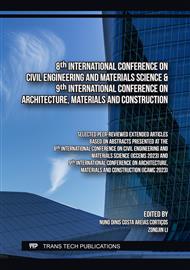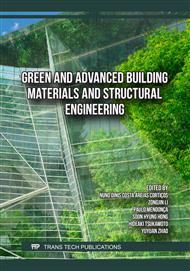[1]
S. Ghabezloo, J. Sulem, S. Guédon, et al. Poromechanical behaviour of hardened cement paste under isotropic loading. Cement and Concrete Research, 2008, 38(12): 1424-1437.
DOI: 10.1016/j.cemconres.2008.06.007
Google Scholar
[2]
X. Pang, J. Qin, L. Sun, et al. Long-term strength retrogression of silica-enriched oil well cement: A comprehensive multi-approach analysis. Cement and Concrete Research, 2021, 144: 106424.
DOI: 10.1016/j.cemconres.2021.106424
Google Scholar
[3]
P. Zhu, Y. Zhao, S. Agarwal S, et al. Toward accurate evaluation of bulk hardness from nanoindentation testing at low indent depths. Materials & Design, 2022, 213: 110317.
DOI: 10.1016/j.matdes.2021.110317
Google Scholar
[4]
H.M. Jennings, J.J. Thomas, J.S. Gevrenov, et al. A multi-technique investigation of the nanoporosity of cement paste Cement and Concrete Research, 2007, 37(3): 329-336.
DOI: 10.1016/j.cemconres.2006.03.021
Google Scholar
[5]
M. Vandamme, F.J. Ulm, P. Fonollosa. Nanogranular packing of C-S-H at substochiometric conditions. Cement and Concrete Research, 2010, 40(1): 14-26.
DOI: 10.1016/j.cemconres.2009.09.017
Google Scholar
[6]
P. Lura, P. Trtik, B. Münch. Validity of recent approaches for statistical nanoindentation of cement pastes. Cement and Concrete Composites, 2011, 33(4): 457-465.
DOI: 10.1016/j.cemconcomp.2011.01.006
Google Scholar
[7]
D. Davydov, M. Jirasek, L. Kopecký. Critical aspects of nano-indentation technique in application to hardened cement paste. Cement and Concrete Research, 2011, 41(1): 20-29.
DOI: 10.1016/j.cemconres.2010.09.001
Google Scholar
[8]
P. Mondal, S.P. Shah, L.D. Marks. Nanoscale characterization of cementitious materials. ACI Materials Journal, 2008, 105(2): 174.
Google Scholar
[9]
F.J. Ulm, M. Vandamme, C. Bobko, et al. Statistical indentation techniques for hydrated nanocomposites: concrete, bone, and shale. Journal of the American Ceramic Society, 2007, 90(9): 2677-2692.
DOI: 10.1111/j.1551-2916.2007.02012.x
Google Scholar
[10]
C. Hu. Nanoindentation as a tool to measure and map mechanical properties of hardened cement pastes. MRS Communications, 2015, 5(1): 83-87.
DOI: 10.1557/mrc.2015.3
Google Scholar
[11]
E.W. Washburn. Note on a method of determining the distribution of pore sizes in a porous material. Proceedings of the National academy of Sciences of the United States of America, 1921, 7(4): 115.
DOI: 10.1073/pnas.7.4.115
Google Scholar
[12]
G. Constantinides, F.J. Ulm. The nanogranular nature of C-S-H. Journal of the Mechanics and Physics of Solids, 2007, 55(1): 64-90.
Google Scholar
[13]
W.C. Oliver, G.M. Pharr. An improved technique for determining hardness and elastic modulus using load and displacement sensing indentation experiments. Journal of materials research, 1992, 7(6): 1564-1583.
DOI: 10.1557/jmr.1992.1564
Google Scholar
[14]
Z. Zhang, J. Qin, Z. Ma, et al. Comparison of three different deconvolution methods for analyzing nanoindentation test data of hydrated cement paste. Cement and Concrete Composites, 2023: 104-990.
DOI: 10.1016/j.cemconcomp.2023.104990
Google Scholar
[15]
Q. Zeng, K. Li, C. Fen, et al. Pore structure characterization of cement pastes blended with high-volume fly-ash. Cement and Concrete Research, 2012, 42(1): 194-204.
DOI: 10.1016/j.cemconres.2011.09.012
Google Scholar
[16]
H.M. Jennings, J.W. Bullard, Thomas J J, et al. Characterization and modeling of pores and surfaces in cement paste: correlations to processing and properties. Journal of Advanced Concrete Technology, 2008, 6(1): 5-29.
DOI: 10.3151/jact.6.5
Google Scholar
[17]
X. Pang, L. Sun, M. Chen, et al. Influence of curing temperature on the hydration and strength development of Class G Portland cement. Cement and Concrete Research, 2022, 156: 106776.
DOI: 10.1016/j.cemconres.2022.106776
Google Scholar
[18]
C. Narattha, A. Chaipanich. Phase characterizations, physical properties and strength of environment-friendly cold-bonded fly ash lightweight aggregates. Journal of Cleaner Production, 2018, 171: 1094-1100.
DOI: 10.1016/j.jclepro.2017.09.259
Google Scholar
[19]
J.J. Chen, L. Sorelli, M. Vandamme, et al. A Coupled nanoindentation/SEM‐EDS study on low water/cement ratio Portland cement paste: evidence for C-S-H/Ca (OH)2 nanocomposites. Journal of the American Ceramic Society, 2010, 93(5): 1484-1493.
DOI: 10.1111/j.1551-2916.2009.03599.x
Google Scholar



